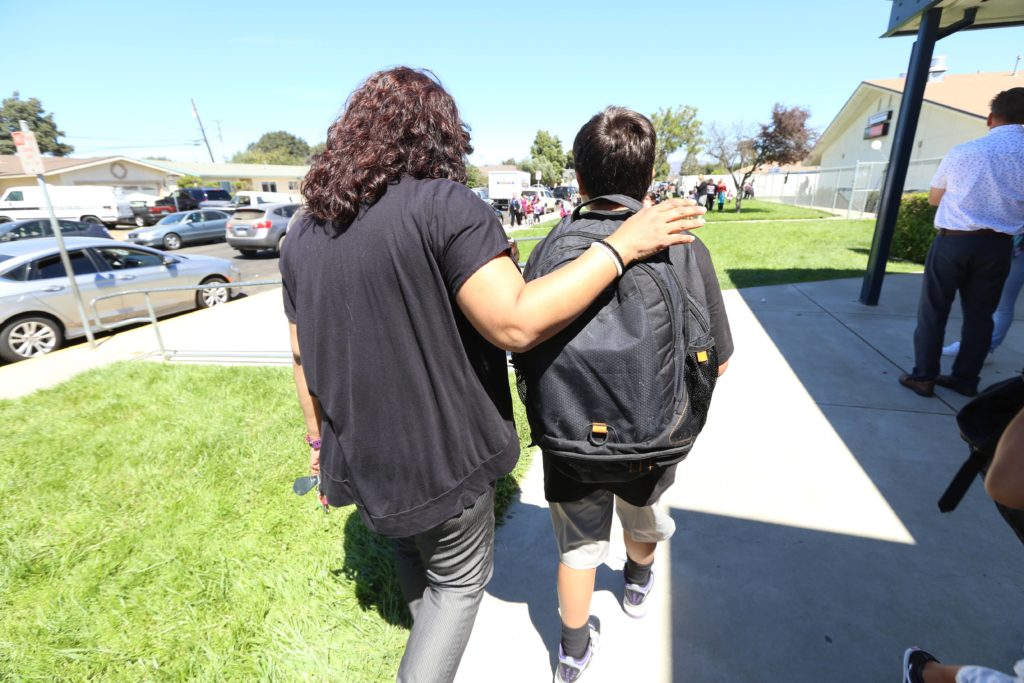
Santa Maria, California. Sol Messeguer who works with Fighting Back Santa Maria, a non-profit agency that provides services to homeless youth and families in Santa Maria.
Credit: Iris Schneider/EdSource
This fall my son lost a classmate to the stigma of being unhoused. The family lost their home during the pandemic when a neighbor’s apartment caught fire, leaving their unit uninhabitable. However, what pushed my son’s classmate out of his seventh grade class and into another school were the taunts from his classmates for wearing the same clothes and coming to school without being showered.
My son’s school did attempt to address this situation. For example, when teachers heard students saying mean things, they would ask the offending student to repeat the comment. The students would not repeat taunts. This approach was meant to signal that this type of language is not OK. However, it fails to address the harm caused by the comments or to support the classmate. Addressing bullying in this fashion doesn’t prevent similar comments in the future. Furthermore, bystanders who witness the bullying also fear being bullied.
Not surprisingly, the entire class was aware of the bullying, yet most remained silent. My son’s classmate understood the students bullying him had their own anxieties and frustrations. He understood them because of his own experiences with instability, feeling stuck and isolation. He understood that his classmates who were unkind to him did not have words to express their frustrations in constructive ways; instead, they looked for someone “weak to pick on.” (His words. Not mine). I was surprised by his awareness and understanding of human behavior, particularly his compassion for those who bullied him and those who remained silent. Unfortunately, hostility toward students without a home is not unique to one school or school district. It is part of the general hostility toward such people.
In May, a public meeting about the 7th Avenue Village (a Homekey project in Los Angeles County’s Hacienda Heights designed to get 142 people off the streets and into a home) had to be shut down when it got out of hand. At recent school board meetings, some have voiced opposition to the project such as this comment: “Protect our kids, our residences, our community, and our businesses.” Interestingly, the commenter seems to be requesting the Hacienda La Puente school board to protect “us” (housed people) from “them” (the unhoused).
Another commenter quoted a school board guiding principle emphasizing building a “safe environment” for the student. He urged board members to “think about students first, not other issues, (not the) homeless issue.” There seems to be a lack of recognition that there are students without housing attending our schools and living in our communities.
Last year, 15 students who had no home attended my son’s school. And there were 543 unhoused students across the Hacienda La Puente school district and 187,298 in the state, according to the California Department of Education’s DataQuest. California and districts are responsible for educating all students, including those with no housing. The federal McKinney-Vento Homeless Assistance Act requires districts to “adopt policies and practices to ensure that homeless children and youth are not stigmatized … on the basis of their homeless status.”
It is difficult for students to learn when they do not feel psychologically, physically or emotionally safe. Housed and unhoused students are dealing with a lot and need to express their feelings, fears and frustrations about things they don’t have any control over.
Here are some things districts must do to create learning environments to support all students:
- All students, housed and unhoused alike, as well as parents, guardians and caregivers, need to be taught to deal with anxiety and frustrations and how to stand with those who are being bullied.
- Districts must invest in training for school site leaders, teachers and families to adopt practices such as restorative justice circles, bystander training and ally programs. Districts need to improve communication about the services available for students who are homeless. A student’s situation can change, leaving them unhoused and unaware of services such as laundry or shower facilities that may be available. Schools should consider waiving fees for students who are homeless so they can participate in after-school activities. (Students’ attendance improves when they feel a connection to the school).
- School board members need to acknowledge that the district is part of a larger community dealing with a growing homeless population because of a lack of affordable housing. The board should direct the superintendent to create systemic change and to demonstrate to the community their commitment to supporting the learning of all students.
As parents, we chose this school because of the dual immersion program. We want our kids to grow up to be global citizens, to be able “to meet the challenges and opportunities of a changing world.” One of the skills we expect of our kids is to be able to advocate for what is right, including speaking up against bullying.
Where are we on this target?
•••
Maria Oropeza Fujimoto lives in Hacienda Heights and is a parent and an associate professor in the educational leadership doctorate program at Cal State LA.
The opinions expressed in this commentary represent those of the author. EdSource welcomes commentaries representing diverse points of view. If you would like to submit a commentary, please review our guidelines and contact us.

